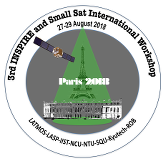Speakers
Dr
Luc Damé
(LATMOS)Dr
Mustapha Meftah
(LATMOS / CNRS / Paris-Saclay University)Prof.
Philippe Keckhut
(LATMOS)
Description
Within the past decade, satellites constellations have become possible and practical. One of the interest to use a satellites constellation is to measure the true Earth Radiation Imbalance, which is a crucial quantity for testing climate models and for predicting the future course of global warming. This measurement presents a high interest because the 2001-2010 decade has not shown the accelerating pace of global warming that most models predict, despite the fact that the greenhouse-gas radiative forcing continues to rise. All estimates (ocean heat content and top of atmosphere) show that over the past decade the Earth radiation imbalance ranges between 0.5 to 1W/m2. Up to now, the Earth radiation imbalance has not been measured directly. The only way to measure the imbalance with sufficient accuracy is to measure both the incoming solar radiations (total solar irradiance) and the outgoing terrestrial radiations (top of atmosphere outgoing longwave radiations and shortwave radiations) onboard the same satellite, and ideally, with the same instrument. The incoming solar radiations and the outgoing terrestrial radiations are of nearly equal magnitude of the order of 340.5 W/m2. The objective is to measure these quantities over time by using differential Sun-Earth measurements (to counter calibration errors) with an accuracy better than 0.05 W/m2. It is also necessary to have redundant instruments to track aging in space in order to measure during a decade and to measure the global diurnal cycle with a dozen satellites. Solar irradiance and Earth Radiation Budget (SERB) is a potential first in orbit demonstration satellite. The SERB
nano-satellite aims to measure on the same platform the different components of the Earth radiation budget and the total solar irradiance. Instrumental payloads (solar radiometer and Earth radiometers) can acquire the technical maturity for the future large missions (constellation that insure global measurement cover) by flying in a CubeSat. This presentation is intended to demonstrate the ability to build a low-cost satellite with a high accuracy measurement in order to have constant flow of data from space.
Primary author
Dr
Mustapha Meftah
(LATMOS / CNRS / Paris-Saclay University)
Co-authors
Dr
Abdanour IRBAH
(CNRS)
Dr
Alain Hauchecorne
(LATMOS)
Dr
Alain SARKISSIAN
(LATMOS)
Dr
Luc Damé
(LATMOS)
Prof.
Philippe Keckhut
(LATMOS)
Dr
Rémi Thieblemont
(CNRS)
Dr
slimane bekki
(cnrs)

